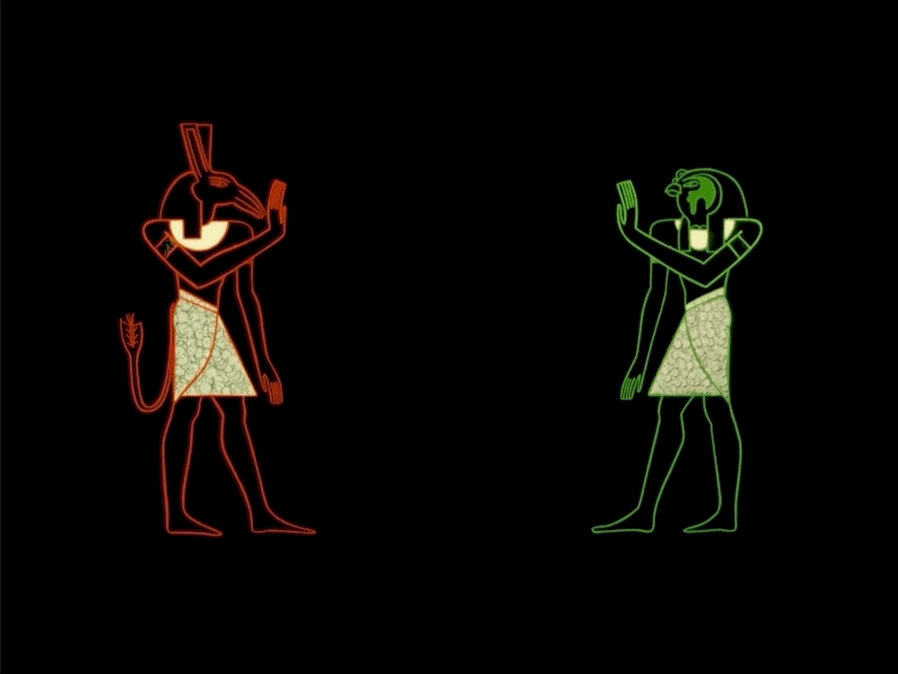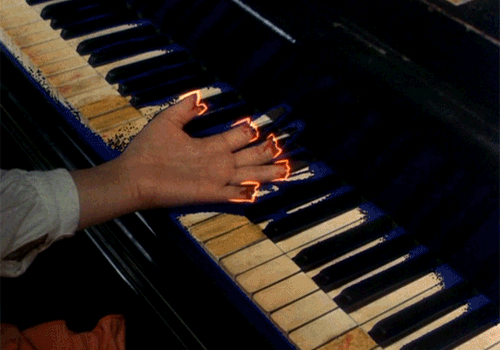The Origins of an Origin Story: An Interview with RA: PATH OF THE SUN GOD Animator Lesley Keen
Leave a CommentGuest programmer Jazmyne Moreno talked to Lesley Keen, the animator behind the lost masterpiece RA: PATH OF THE SUN GOD, about its origins and how it was almost lost to the ages. The film finally receives a theatrical premiere almost 30 years after its creation this Wednesday, March 13th, during SXSW, presented by AFS with a new, live score from Holodeck Records artists Majeure, Curved Light and True Creature (TICKETS).
What sparked your interest in animation?
My earliest memory of seeing animated film was on ‘This Wonderful World’, a mainly documentary series presented by John Grierson on Scottish Television in the early ’60s. These were not cartoons as I recall, but more experimental works. It is possible films by Norman McLaren may have been amongst these but it was more the works from what was probably Hungary and Czechoslovakia that caught my attention.
How did you get your start?
I had no particular intention to study animation when I went to the Glasgow School of Art but a first year project, a very basic cut-out exercise shot on a wind-up 8mm Bolex, gave me a taste to do more. Many years after (Norman) McLaren created his drawn on film techniques for lack of equipment, animation was still not on the curriculum at GSA so my student work was not informed by any formal training in the subject. I was self-taught with the exception of a week spent learning the basics on the course Bob Godfrey ran at Guildford College of Art.
Your work often mixes mythology and cosmology, what is your interest and attraction to these two topics?
In the early 80s I started to study ideas from psychology, comparative religion and quantum mechanics. I can’t point at anything really specific but I would say my interest in creation myths probably grew out of reading Jung and exploring symbolism and archetypes.

In the ‘80s, you are among a long list of animators who had works commissioned by Channel 4. This list includes the Brothers Quay, Jan Svankmajer, and Nick Park among others, can you describe the impact Channel 4 had on your career?
The establishment of Channel Four with its radical remit to open up the TV market to new voices in the early 80s was transformative to the independent filmmaking community. There were no constraints beyond the remit to create programmes that brought new perspectives and took risks. My commissioning editor, Naomi Sargant, did not come from a TV background and had no experience and had no preconceived ideas of what animation should be about, which allowed us complete freedom to innovate. Without her vision and position of influence at Channel 4, RA would never have been made.
How did RA: THE PATH OF THE SUN GOD come about?
RA was my third commission from Channel 4, after TAKING A LINE FOR A WALK and ORPHEUS AND EURYDICE, both of which had accompanying documentaries. Even with C4’s innovative approach to scheduling, there is a limit to the impact that can be made with one-off short films. I wanted to create a piece that would be substantial enough to command a prime slot without the need for a documentary wrapper. A piece on Egyptian themes had been part of an earlier proposed series of films based on mythological themes, of which ORPHEUS was to be the first. Egyptian art and mythology provided a wealth of material to create a longer piece so RA was originally commissioned as a half hour programme. But as we got into production it became obvious that there was too much content in the storyboard to fit into this timeslot. So the programme was restructured into three half hour parts.

You spent four years working on RA, can you tell us about the production?
Naomi Sargant was the commissioning editor for educational programming so she set the condition that the production be as faithful to its Egyptian sources as possible. Specialist insights and guidance on the Egyptian sacred texts and visual symbolism were provided by our consultant Egyptologist, Dr. Geraldine Pinch. The very distinctive graphical look grew out of a need to differentiate the intangible realm of the gods from of the human dimension, to create a visual grammar where the sacred and profane worlds could coexist and yet be recognizably distinct.
The look was achieved by representing the gods using ‘negative’ artwork with coloured gels over the lens and depicting the human dimension using top lit artwork, coloured lines on animation cels. All of the exposures were made in the camera, with no optical lab effects, using a computerized rostrum to run accurate multiple exposures using mattes to separate the back and top lit passes. Since the representation of the Nun, the moving dot formation present in many scenes, had to run continuously, all edits had to predefined. The exposure sheets needed to be pin accurate and followed to the frame.


And the music?
The music for the film was composed by Scottish musician Tom Rennie. Tom created the music to picture, since until the scenes were shot the atmosphere could not be judged and matched. One of the hardest challenges at the time was to pitch shift and build a chorus of Eunuchs from a single recording of our female voice artist, Tamara Kennedy!
RA is an exquisite piece of animation, however it has remained relatively unknown. What happened to it?
The relative obscurity started at the point when it was first broadcast. Ra was the most expensive animated commission Channel 4 had ever made and the original plan was for a major launch on a prime time slot, with an accompanying book. All of this was dismantled before the production was completed when our commissioning editor lost her position as C4 started moving in a different editorial direction. However, Ra ended up being split up and broadcast over three consecutive Sunday afternoons, with none of the planned promotion. The option for a second screening was never exercised.
Ra was sold to various international TV stations and received a limited video release through the BFI.

Were you surprised by Holodeck Records’ interest in the film?
I was really surprised to learn of Holodeck’s awareness of the film’s existence and delighted that it held this attraction! I am intrigued to hear this new creative interpretation, where the film itself provides the inspiration and I have no influence over the musical composition.
We always love a good film recommendation, are there any animated works you could recommend to us?
The work being done at the National Film Board of Canada in the 70s and 80s was very influential in terms of opening up new ideas about technique and structure. A standout piece for me is AFTERLIFE, by Ishu Patel, which used backlighting in combination with clay to create an otherworldly effect. Other influential pieces would be THE HEDGEHOG IN THE FOG by Yuri Norstein, for its handling of atmosphere, and THE STOLEN AIRSHIP by Karel Zeman, the film that was instrumental in attracting me to Czechoslovakia in the 70s.
What advice would you give to budding filmmakers?
The challenges today are really the opposite of what I experienced, when the barriers to entry were high with limited access to the means of production and distribution opportunities. Now the enabling technology is easily available and the field is wide open to anyone to make their work and put it out there on a growing number of platforms. The world is now inclusive rather than exclusive, but this brings a new set of challenges, mainly discovery of your work in an uncurated sea of content. I think however the underlying issues remain the same on a personal level. As a creator you need to be resilient, have confidence in your own abilities and most of all, never give up on your vision.
What are you working on at the moment?
I am currently exec producing a children’s animated series, calling back to my early training in the Czech animation studios. I have also returned to experimenting with the moving image, creating a series of non-narrative abstract compositions: www.10k-project.com/ The 10k project has been designed as a collaborative project, taking the visual track as a starting point and letting it be reshaped through interaction with sound design and musical composition.
As RA is receiving not only its US premiere, but first theatrical screening, with a new score by Holodeck Records, what are your hopes for the film going forward?
I am very excited by the potential vistas that this screening could open up. It is my hope and wish that Ra will finally connect and resonate with its true audience and I am really looking forward to exploring the creative possibilities of this new collaboration to bring Ra into the full light of day.


All images (c) Total Immersion Ltd. 2019.












